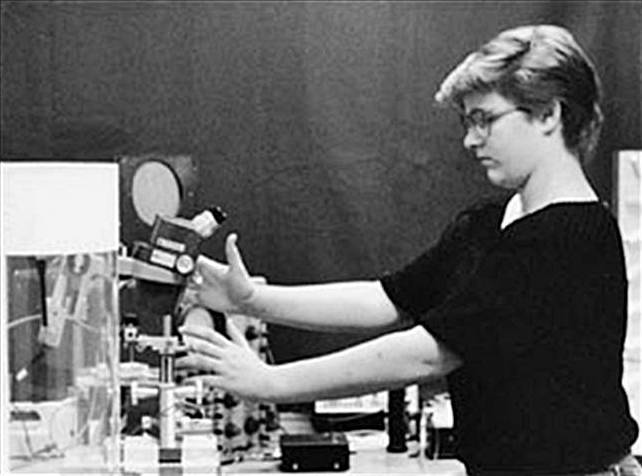Christina Boyer accepted a plea bargain in 1994 to avoid the possibility of a death sentence. Christina alongside her new boyfriend, David Herrin, was convicted over the death of her three-year-old daughter, Amber. Her case made headlines not just for the tragic death of her daughter, but because of Christina’s real name and who she used to be: Tina Resch, the girl behind the infamous Ohio poltergeist case.
Tina’s tragic life began when she was only ten months old. Her mother abandoned her and her father had never been in the picture. The baby was immediately put into the foster care system, which appointed her to the foster home of the Resch family. The Resch couple were well known throughout the community, having fostered around 200 from their modest home in the suburbs of Columbus. As charitable and caring as they appeared to be, the truth about the Resch couple was that they were stern disciplinarians that often verbally and physically abused Tina. This proved to be the catalyst for what was to be one of the most intriguing cases of psychokinesis ever recorded.
Tina, The Girl
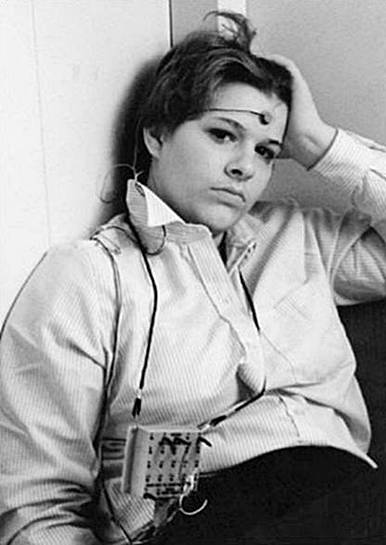
Psychokinesis. What is it? It’s defined as the ability to influence the natural environment around you without having physical contact. In other words, the psychic ability to move objects. Recurrent Spontaneous Psychokinesis (or RSPK) is the term given to supposed poltergeist activity. The term RSPK is used when there are recurrences of spontaneous physical phenomena around an observed agent. For the most part, poltergeist or RSPK agents tend to be children, teenagers, or young adults. Typically pubescent or pre-pubescent girls are at the top of the list when it comes to possible agents. In Michael Clarkson’s book: “The Poltergeist Phenomenon: An in-depth investigation into floating beds, smashing glass, and other unexplained disturbances” he quotes two Italian physicists, Piero Brovetto & Vera Maxia, and their hypothesis that observers that some changes in the brain occur during puberty that involve fluctuations in electron activity that, in very rare cases, could possibly create the unexplained phenomenon. Brovetto and Maxia’s research dives deep into the developing brains of children and the effects it has on the child’s surroundings. Many of these agents come from emotionally unstable homes and have complex and unnatural relationships with those closes to them. Bouts of anger, depression, and uncontrollable rage are typical associations with an RSPK agent. In Tina’s case, she checked all the boxes for an RSPK agent.
On February 29th, 1984, the then 14-year-old Tina had a loud and volatile confrontation with John Resch. It was a shouting match between the two, something that John had grown accustomed with, given that the teenager had a growing and uncontrollable temperament. In school she was bullied and ostracized by the other children and had become somewhat of a constant disruption for her teachers. As a result of this she was homeschooled. The way John and Joan dealt with Tina’s rage was to implement corporal punishment. It was reported that Joan would often slap her across the face when Tina talked-back and when she got too old for the slaps, John would sometimes beat her into submission. Things only became worse as the teenager developed.
After that particular fight with John, things changed in the Resch household. The following day on the first of March, a cold snowy morning, common objects around the house started disappearing. At times, some objects would move or levitate across a room as if propelled by an invisible force. The Resches bore witness to these strange, paranormal disturbances. The television set would turn off and on, not mattering if no one was watching it or if it even was plugged into the wall socket. The lights around the house also turned off and on and seemed to flicker wildly at times. To this, an electrician and friend of the family, Bruce Claggett, was called to the house to inspect the wiring. Claggett was unable to find the cause for the flicking lights or strange behavior of appliances inside the house. As the relationship between Tina and her foster parents grew more explosive, so did the surrounding events.
The flying objects were now targeting Tina and anyone that happen to be near her. Hearing about the disturbances inside the Resch household, the Franklin County Child Services sent a Ms. Lee Arnold to check on the welfare of Tina and those other children inside the house. It was Ms. Lee, a government employee, who witnessed some of the strange events that day. Eventually the word got out, and more people began to pay an interest to the strange incidents that were occurring inside the residence of Tina Resch. Mike Harden, a reporter for the Columbus Dispatch, and his photographer, Fred Shannon, together paid a visit to the Resch residence, only to come out of it convinced that there was definitely something supernatural happening inside and that it seemed to center around Tina, the otherwise shy teenage girl.
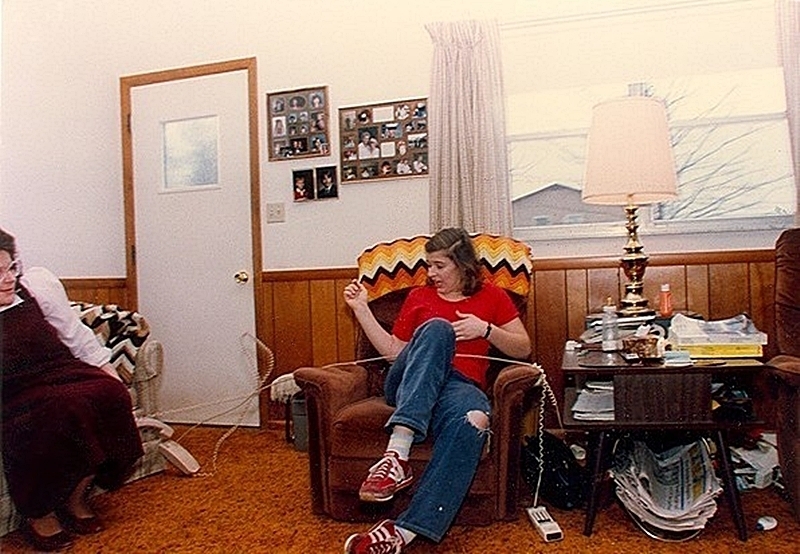
Tina was facing me and I saw her hands. It really shook me up because I couldn’t explain what was going on.”
— Ms. Lee Arnold, Franklin County Children Services, Franklin County, Ohio.
While in the residence, Mike had witnessed a cup of coffee lifting on its own and flipping across the room, spilling it onto her lap and then crashing into the fireplace. Disturbed, he and his photographer remained on high-alert for the rest of the night. It was while they were all sitting in the living room, Tina was sitting on a recliner in full view of everyone, when a telephone next to her suddenly flew across the room. Fred Shannon happened to have his camera trained at the right spot, managing to capture several frames of photographs that showed how the telephone flew past a startled Tina and Ms. Lee. This was to be known as the infamous Frame 32 photograph.
It seemed to me that I was witnessing something which defied both my sceptical instincts as a journalist as well as all of the traditional laws of physics.”
– Mike Harden, Columbus dispatch.
The news team had witnessed enough activity in the house to make contact with Dr. William Roll, Director of the Psychical Research Foundation in North Carolina. Dr. Roll had previously worked at the Duke University under Prof. JB Rhine, one of the founders of modern Parapsychology. Dr. Roll and his assistant arrived in Columbus on March 11th, by then there had been a full-blown media circus outside the home. There were television crews and reporters hounding the family and neighbors for first-hand accounts of the strange goings-on inside the Resch residence. Just before Dr. Roll’s arrival, the Resch family caved into the demands of the reporters and had conducted an interview inside the house. Tina, John, and Joan would be the ones in front of the cameras, confessing all the strange things that had happened to them within the last few days.
Caught Faking Evidence
More reporters arrived early on the afternoon of March 8th. They brought with them dozens of photographic and video cameras that were positioned in strategic locations throughout the house as well as fixed upon the 14-year-old Tina at all times, who by that time was growing anxious. As the hours passed and the reporters kept pressing on, John and Joan began showing signs of frustration. Everyone was expecting Tina to satisfy their curiosity. According to Dr. Roll account, Joan had pulled Tina to the side and said to her: “Something has got to happen…”
Tina felt a tremendous pressure from her foster parents and from the reporters to produce some sort of poltergeist effect, as if she had control over it. John was becoming more frustrated, deflecting the anger towards Tina. By that time it had been nearly 8 hours and the nothing, absolutely nothing had been observed by the gathered crowd. However by 9:30 PM that night, something did happen. Drew Hadwal of WTVN-TV in Columbus had setup a camera to be focused solely on a large table, when a lamp that was on it was suddenly knocked off. To the relief of the Resch family, the reporters were thrilled to have captured something unexplainable on tape. Once they had their footage, the crowd slowly began dissipating and the caravan of cars and vans finally left the family alone.
Drew Hadwal rushed back to the news station hoping to have the clean edit of the of footage ready for the late night news segment. However it wasn’t until he was in the editing room that he noticed Tina in the footage, inching closer from the sofa to the table. On film, he caught her looking over her shoulder and when no one was looking, swatting the lamp off the table with her hand. The camera man, as well as the entire crowd, had been duped by the teenager.
Enter The Magician
The news team aired the footage of her trickery and soon after the public’s opinion changed on Tina. She was able to get rid of the news crew but Tina’s tricked had cost her the frail credibility she desperately clung onto. Yet there were still many of those who had witnessed the strange events and swore that Tina could not have been behind the things they’ve witnessed. Family members, friends of the family, neighbors, even the some members of the media, bore witness to paranormal incidents that they swore were not caused directly by Tina. This included reporters like Mike Harden from the Columbus Dispatch and Ms. Lee Arnold from the Franklin County Children Services.
On the 13th of March, James “The Amazing” Randi arrived at the Resch household. Randi, a stage magician and skeptical investigator was more known for his ‘Million Dollar Challenge’. One million dollars, payable to anyone who can prove paranormal or poltergeist activity under his observations and examinations. He had arrived to the location with a few other researchers from the Committee for the Scientific Investigation of Claims of the Paranormal, or CSICOP, to conduct a thorough investigation into the Resch case. Randi, being a showman, pulled out a check for the $1 million dollars in front of the cameras that were gathered outside. The flamboyant magician knew how to work the crowd. He had garnered attention in the previous years exposing frauds who claimed paranormal powers. The fact that the million dollars remained unclaimed made Randi and his team more confident that they would soon solve Tina’s problem, as they had ran into these types of claims of poltergeist activity before.
Having had previous encounters with him, Dr. Roll wanted nothing to do with James Randi or the CSICOP team. Dr. Roll felt that their theatrics and presence would be an interruption to the ongoing investigation. Roll needed to have the environment as close as he could to the actual day-to-day life of the Resches in hopes of producing some of the phenomena. Not being allowed to have a look inside, Randi then claimed that Dr. Roll and the Resches were hiding something. They even attempted to discredit the electrician that visited the home a few days before, saying: “[Bruce] gave strange and contradictory accounts of the wonders in the Resch household.” Randi also dismissed Fred Shannon’s photograph, saying that it showed “transverse blurring” which indicated that the phone had been thrown by Tina herself.
Regardless of what James or the CSICOP team said, Dr. Roll kept the environment as free from distractions as he could. In his book, Dr. Roll said: “…Above all, Randi failed to realise that the occurrences took place under informal circumstances in a private home, not in a laboratory. He went on to claim that the occurrences around Tina, if genuine, would amount to “a repeal of the basic laws of physics.” Physics does not say that objects cannot be affected without tangible contact. The Moon revolves around the Earth and magnets attract pieces of iron without visible contact. Recurrent spontaneous psychokinesis requires an extension of the laws of physics, not their repeal as Randi imagines.” – Dr. William Roll, “Unleashed: The curious story of Tina Resch“.
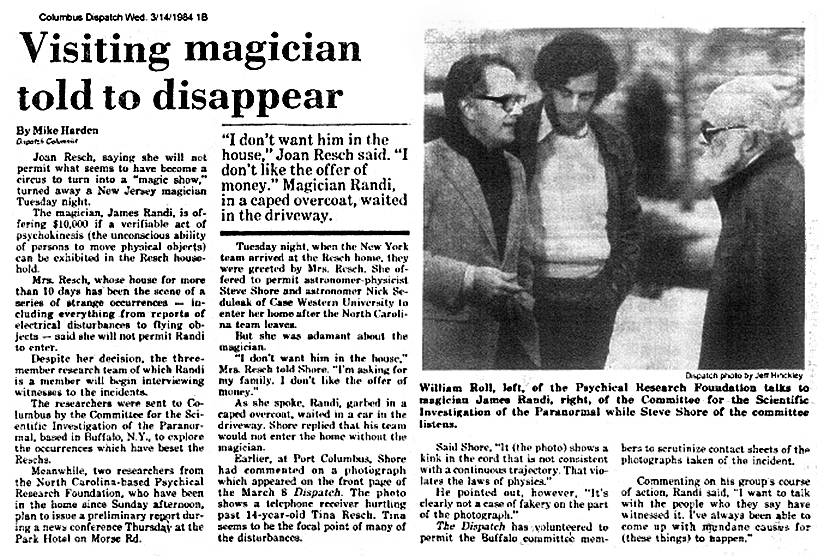
Inside Tina’s Head
Dr. Roll had advised Tina’s foster parents to take her to see a neurologist, to see if the child suffered from complex partial seizures or any other type of seizure she may be subject to. Neurologist John Corrigan did the testing and reported that no epileptic spikes were seen in her brain wave records. However Dr. Corrigan did find that the testing demonstrated some slight muscle jerks, blinking, twisting and twitching. Which were conducive to a mild form of Tourette’s syndrome. This was a key finding. Tina was constantly suppressing her need to express herself, often times this need made her yell out profanities and have uncontrollable outbursts due to her frustrations. She was beat, mistreated, or ridiculed by her parents and peers whenever this occurred. This only added more fuel to the fire that was roaring inside the misunderstood teenager.
Three visits and several tests later, the neurology analysis concluded that there were some anomalies in Tina’s brain stem which affected with the day and night functions and the parasympathetic system. Another doctor, Dr. Steve Baumann, found that the anomalies in Tina’s upper brain stem showed faster than usual streams of electrical impulses in the pons region (mid-brain). Doctor Roll also observed that the day of Tina and John’s volatile encounter, there was a geomagnetic storm. This, combined with the “Tourette-type discharges” may have attributed to the RSPK events that unfolded soon after.
In the early 1970s, Dr. Roll alongside professor Livingston Gearhart, coauthored a study into RSPK cases and geomagnetic disturbances. They argued that uncommon animal migrations and other unusual behavior (pets running away) tended to occur on days of higher than usual geomagnetic activity. This led them and others to see that there were a large number of reported RSPK cases that coincided with the geomagnetic storms that were happening around the world at the time. The geomagnetic disturbances combined with Tina’s erratic electrical impulses on her brain stem was to be the perfect storm for RSPK activity.
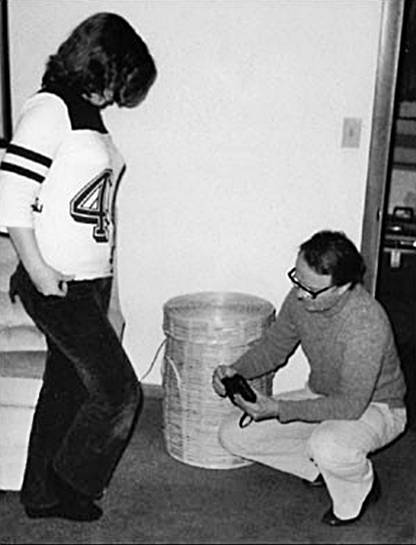
As the months passed, interest in the case by the media began to diminish. Tina would often visit Dr. Roll in his lab in Durham, North Carolina. They continued experiments and interviews day after day, hoping to gather as much information possible. A tedious job for Dr. Roll and his team, but a much welcomed change of scenery for Tina. Since the start of the poltergeist activity, the relationship between Tina and her foster parents fell further apart. By then, the media attention had completely died. Many saw Tina as a charlatan, a hoaxer who wanted nothing more than attention. John and Joan blamed her for what was happening around their house and denied her any love or moral support to show their disproval and disappointment. Everyone seemed to think that the Resches were in on the hoax as well. So they in turn blamed Tina for the loss of their good standing in that small community. She felt betrayed, unwanted by the Resches, just like her birth parents. She was being abandoned all over again.
The testing at Dr. Roll’s lab showed further hardships that Tina had endured throughout her short life. Psychological testing revealed signs that she lived a neglected and extremely abusive past. There was no psychosis observed however. When Tina was hypnotized, Dr. Roll and staff were able to observe an object take flight. The object was moved about 40 feet and even rounded corners during its flight trajectory. This lead Roll and his team to speculate that an RSPK agent was powered by some form of zero-point energy, created by Tina’s powerful subconscious mind.
Precursor To RSPK
There were only a few adults in Tina’s life that offered her the compassion and attention she deserved and craved as a child. It wasn’t until Dr. Roll’s investigation that Tina’s full past came into the light. Illuminating an abusive and horrendous life that afflicted the young girl. Tina’s mild Tourette’s Syndrome diagnosis could be seen as symptom to the abuse. Her need to express her anger towards her mother and father, her anger towards her foster parents, and to the system that failed her miserably. It had come to light that Tina had been sexually molested by her foster brother at the age of thirteen. That same year, the only person that Tina ever trusted and loved, her best friend, was killed in a horrible automobile accident.
It’s no surprise that someone with such a background could be involved in claims of psychokinesis or telekinesis. There are many other cases in parapsychology that show that a young teenaged girl could becoming something of an RSPK agent. Manifesting poltergeist or ghostly activities around them and their homes. Anne Marie, from the Rosenheim Poltergeist, the Doris Bither case, the girls from the Enfield Poltergeist, Pascuala Alcocer and the Zaragoza poltergeist, and the Jackie Hernandez haunting are just some cases that are similar to that of Tina’s. These were young girls and women who displayed signs of RSPK disturbances just like Tina. And just like Tina, they were vilified, ostracized, and overlooked by those who dismissed their plight as just another way of getting attention.
Beyond The Haunting
When Tina was fifteen, she attempted suicide out of desperation. She was prescribed Ritalin and other medications for what the doctors assumed was a severe case of Attention Deficit Hyperactivity Disorder (ADHD). Soon after, Tina started running away from home. For the next few years, Tina moved back and forth between Columbus and Durham. Staying with Dr. Roll and his wife while undergoing examinations under the doctor’s supervision. While in Columbus, her stay in her foster parents’ home was anything but normal. The events behind Tina’s life had caused a major disruption to John and Joan’s personal life. Caring much for what the neighbors and friends had to say, the couple would often blame Tina for their hardships. The disruption was enough to make them finally move out of that house and town in 1986.
Once they sold the house, the Resches told Tina that she had to find another foster home to live in. They wanted to part ways with the unruly teenager they claimed Tina to be. The courts stepped in and gave Tina two options: Go into a juvenile detention center or live with her much older boyfriend, James Bennett. At the age of 16, Tina married.
Within a year of living with Bennett, Tina was physically abused by him. Forcing her to escape her home once again and seek refuge at a women’s shelter. That same year, John Resch passed away. John’s mother (Tina’s foster grandmother and only adult to really care for her) passed away shortly after, leaving Tina around $5,000 dollars in savings. Bennett made sure that Tina didn’t see a cent of that money, taking it for himself. It wasn’t too long after that incident that Tina finally left him for good. The two were soon divorced and by 1988 Tina had become pregnant by another man, whose name she never gave.
She began seeing another man named Larry Boyer, who later married the young, single mother. Not long into their marriage, Boyer attacked and beat Tina so bad she was became unconscious during one of the attacks. It was then that Dr. Roll received a phone call from the battered mother. She needed his help once more and he obliged. Letting Tina and her baby stay with him and his wife. During this time in her life, Tina was becoming self-sufficient. Taking nursing and computer classes, she was becoming the mother she never had for her baby daughter Amber. In 1989 Tina met a man by the name of David Herrin and by all accounts the couple had a normal start into their relationship. As their relationship grew the couple moved on with their lives. Ending the contact she had with Dr. Roll due to the demands of parenthood and life in general.
A Senseless Murder
On the morning of April the 15th, 1992, Tina and her boyfriend David were arrested and charged for the murder of three-year-old Amber. According to the her story, the week prior to her daughter’s death, Tina had noticed bruises all over Amber’s body. When she confronted David about the bruises, he explained to her that the child had taken a nasty fall, causing the injuries. Tina decided to not take the child to the hospital due to fear of Child Protection Services taking her away. Tina was fearful of courts and the type of social services she had grown up around. Her decision to forgo medical attention for her daughter would cost her severely.
The day of her daughter’s death, Tina had been visiting some friends and had left Amber in the care of David. While visiting Jeanne Lagle, a close friend, Tina received a phone call from David, informing her that Amber would not wake up. Tina rushed home to find her daughter unresponsive so they rushed the toddler to the emergency room. Amber was declared dead upon arrival. Upon examination, the doctors reported several internal and external injuires to the body. Some of the injures were old, some were recent. It was determined that the internal injuries were caused by Amber being sodomized.
Tina, The Woman
David Herrin denied ever laying a hand on the child. As the investigation went on, his story soon crumbled. He admitted having hit the child, then admitted to sodomizing her. The police slapped a murder charge on the couple and they were booked into the county jail.
The murder charge meant a possible death penalty for Tina, who by now went by the name Christina Boyer, a heavy price for a crime she didn’t commit. If anything, Tina had been guilty of child endangerment and neglect. However due to grief, or guilt, she felt that it was the punishment she deserved. Tina’s public defender didn’t help either, not making much of an effort to gather evidence and testimonies to support Tina’s innocence for the crime of murder. Tina had an alibi for her whereabouts that day, if the defender bothered to check. The day of the incident, David had been fired from his job and the only one with Amber during that time. Tina was held for two years in jail before facing a jury of her peers. While in jail, she had once again become victim to the bullying of others. For those that don’t know, when inmates find out that a person is in jail for hurting or killing a child, you become an instant target.
Tina had very little interaction with the public defender, in fact, one of the few and final times the two spoke was when the defender called Tina a week or so before her trial, that if she pled guilty, the judge would take the death penalty off the table. Under the circumstances and under little to no counsel, Tina decided to pled guilty on October 24th, 1994. The judge gave her life, plus twenty years with no possibility of parole. While she had testified against Herrin, Tina was once again subjected to humiliation and to a point, vilified, because of her previous life as Tina Resch, the girl behind the Ohio Poltergeist.
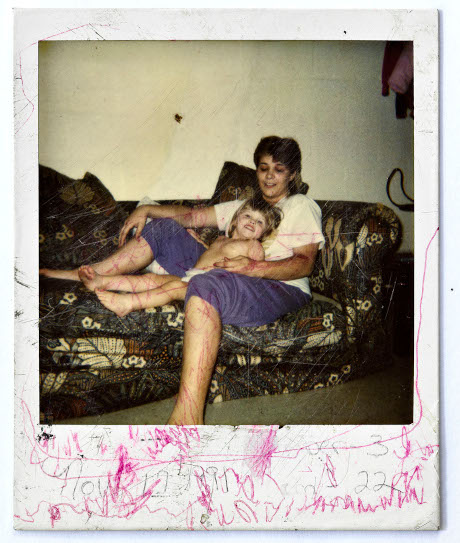
Sources used: Michael Clarkson: The Poltergeist Phenomenon | Jamesconrad.com | Dr. William Roll: Unleashed: The curious story of Tina Resch | WCMH-TV Channel 4. 1984 Columbus, Ohio.

